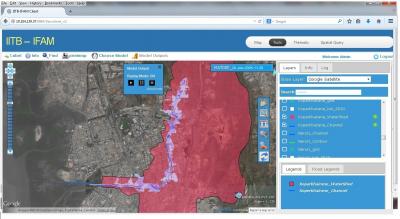
Floods in Mumbai due to heavy rains on 26th July 2005 took a toll of more than 400 lives and resulted in economic loss of over Rs. 5000 crore. The events of that day highlighted the importance of designing constructions for floods. A flood model that can predict the amount of flooding in a region could be of great utility in minimising the damages.
There are several flood models that provide information on the water levels and areal extent of inundation in a region and thus assist assessing vulnerable areas. However these models are complicated, costly, data intensive and require high level of expertise to simulate. Hence, the benefit of use of advance datasets cannot be realized by the stakeholders or the local communities who are directly affected by flood events.
But things are set to change. A new work from Civil Engineering Department and CSRE at IIT Bombay is geared to make flood assessment easy. The work integrates a flood assessment model with web based Geographical Information System (GIS) framework to create a web enabled tool that is easy to access, use, and does not require special hardware or software system at user end. Prof. Eldho and his team are of the view that development of such a web GIS based distributed flood assessment model has not been reported elsewhere earlier, in the country.
The model is presently geared for urban cities in coastal Navi Mumbai. Indeed the model has been tested for its application for twelve urban catchments in Navi Mumbai. The work has been sponsored by Department of Science and Technology of Government of India.
When questioned if this model could be used to predict 26th July 2005 kind of floods, Professor Eldho reminds that this would depend on availability of information regarding impending rainfall. However such information is not readily available, he adds as a caveat.
However this should not distract from the utility of model, since the web based GIS system, called Integrated Flood Assessment Model (IFAM) can still be used for giving information on possible levels and areal flood inundation extent patterns of flood at any location for different rainfall intensities. This is useful for identifying the vulnerable areas in the catchment and also to assess the capacity of existing main channels in the catchments.
This ‘Flood Tool’ – if we might call it that, integrates Web GIS System developed on Java with Integrated Flood Assessment Tool developed in MATLAB. The ‘Flood Tool’ has to be populated with a static catchment specific data like digital elevation model and channel geometry while the dynamic data such as rainfall, tidal level, simulation time etc can be fed through a web browser.
The ‘Flood Tool’ is easy to use. Indeed once the data sets have been populated, even a non expert user can simulate flood scenarios for different rainfall intensities and see results over a browser. As earlier mentioned, if rainfall forecast is available, this tool can even predict the flood near real time. Otherwise also, the IFAM model can be used for various design purposes, disaster and risk management.
The team: Professor T I Eldho, Prof. E P Rao from Civil Engineering Department and Prof. B Krishna Mohan from CSRE, at IIT Bombay who are the principal investigators, while A T Kulkarni, who is pursuing his PhD in this area, and J Mohanty have been the research fellows under this project.
Prof. T I Eldho
Prof. E P Rao
Prof. B KK Mohan
